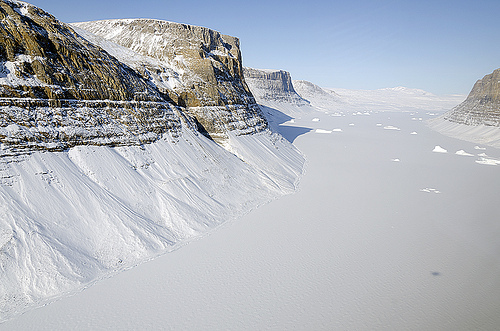美國太空總署空中科學實驗室和國際研究團隊以探冰雷達觀測發現,格陵蘭冰層下近1英哩處竟存在一道極長且深的大峽谷。這道基岩峽谷從靠近格陵蘭島的中心位置一路延伸置最北邊一處連接北極海的峽灣。
這條看似蜿蜒的河流水道至少有460英哩(750公里)長,比美國科羅拉多河的大峽谷還要長。最深處深達半英哩,規模等同大峽谷。科學家說,彼得曼冰川峽灣下這道巨大的峽谷比覆蓋格陵蘭的冰層還要古老,起碼數百萬年。
美國太空總署和來自英國及德國的研究團隊,歷經十多年來蒐集數千英哩的空中雷達數據,終於拼湊出格陵蘭冰層下的地景。
大部分的資料來自2009年至2012年NASA冰橋行動蒐集的數據。冰橋行動是NASA研究極地冰層的計畫,其多通道相干雷達測深儀可以穿透冰層,測量深度和下方基岩的形狀。在某些特定的頻率,無線電波可以穿過冰層、撞到基岩後回彈。研究人員以回彈所花的時間計算出峽谷的深度。時間越長,表示峽谷越深。
研究人員相信,峽谷可將冰川下的融化雪水從格陵蘭內陸運輸到冰層邊緣入海。證據顯示,冰層出現以前,也就是大約4百萬年前,水從內陸經峽谷流到海岸,形成主要河川系統。
「Google街景上有世界各地城市的景象,數位地圖從人口密度到快樂指數應有盡有,讓人們以為地球上的地景已經被人類了解得差不多了。但我們的研究顯示,地球還有很多有待人類探索之處。」英國布里斯托大學自然地理學教授Jonathan Bamber說。
「格陵蘭大峽谷的發現,顯示地球上還有許多秘密有待發現。750公里長的峽谷藏在冰層下數百萬年,除了讓人歎為觀止外,也有助於我們了解格陵蘭的歷史。」英國劍橋大學南極研究計畫ice2sea協調人David Vaughan教授說。
冰橋行動科學家將於2014年三月回到格陵蘭,繼續以透冰雷達等儀器蒐集極圈陸地上和海冰上的數據。
Using ice-penetrating radar, scientists have discovered a long, deep canyon that exists a mile beneath the Greenland ice sheet, data from a NASA airborne science mission and an international research team reveals.
The scientific team identified a continuous bedrock canyon that extends from almost the center of the island and ends at its northern extremity in a deep fjord connecting to the Arctic ocean.
Using ice-penetrating radar, scientists have discovered a long, deep canyon that exists a mile beneath the Greenland ice sheet, data from a NASA airborne science mission and an international research team reveals.
The scientific team identified a continuous bedrock canyon that extends from almost the center of the island and ends at its northern extremity in a deep fjord connecting to the Arctic ocean.
The canyon looks like a winding river channel at least 460 miles (750 kilometers) long, making it longer than the Grand Canyon of the Colorado River in the United States. In some places, it is half a mile deep, on the same scale as parts of the Grand Canyon.
Scientists say this immense feature beneath the Petermann Glacier fjord is even older than the ice sheet that has covered Greenland for the last few million years.
“One might assume that the landscape of the Earth has been fully explored and mapped,” said Jonathan Bamber, professor of physical geography at the University of Bristol in the United Kingdom, and lead author of the study.
“With Google Streetview available for many cities around the world and digital maps for everything from population density to happiness one might assume that the landscape of the Earth has been fully explored and mapped,” said Bamber. “Our research shows there’s still a lot left to discover.”
Bamber and his team published their findings Thursday in the journal “Science.”
The scientists used thousands of miles of airborne radar data, collected by NASA and researchers from the United Kingdom and Germany over decades, to piece together the landscape lying beneath the Greenland ice sheet.
Much of this data was collected from 2009 through 2012 by NASA’s Operation IceBridge, an airborne science campaign that studies polar ice. One of IceBridge’s scientific instruments, the Multichannel Coherent Radar Depth Sounder, can see through vast layers of ice to measure its thickness and the shape of bedrock below.
At certain frequencies, radio waves can travel through the ice and bounce off the bedrock underneath. The amount of time the radio waves took to bounce back helped researchers determine the depth of the canyon. The longer it took, the deeper the bedrock feature.
The researchers believe the canyon plays an important role in transporting sub-glacial meltwater from the interior of Greenland to the edge of the ice sheet and on into the ocean.
Evidence suggests that before the presence of the ice sheet, as much as four million years ago, water flowed in the canyon from the interior to the coast and was a major river system.
Said Professor David Vaughan, ice2sea co-ordinator based at the British Antarctic Survey in Cambridge, England, “A discovery of this nature shows that the Earth has not yet given up all its secrets. A 750km canyon preserved under the ice for millions of years is a breathtaking find in itself, but this research is also important in furthering our understanding of Greenland’s past.”
“This area’s ice sheet contributes to sea level rise and this work can help us put current changes in context,” said Vaughan.
The IceBridge scientists will return to Greenland in March 2014 to continue collecting data on land and sea ice in the Arctic using a suite of instruments that includes ice-penetrating radar.
※ 全文及圖片詳見:ENS








